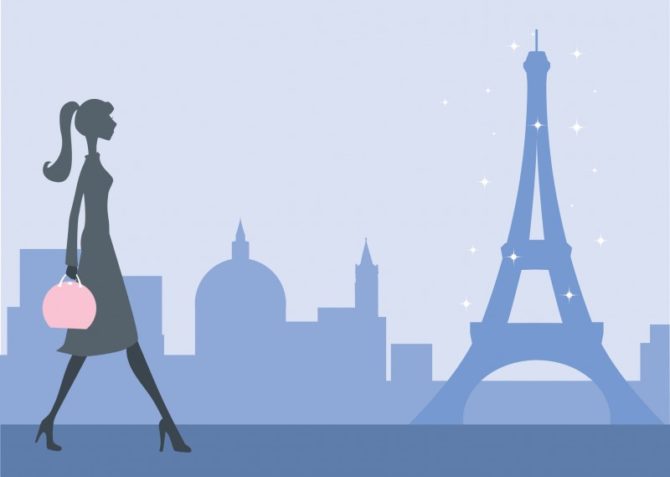L’Esprit Parisien

I just saw a pub (magazine ad) in Figaro Madame selling “l’esprit parisien.” Quoi? Depending on context, l’esprit parisien-the essence of Paris-can mean three different things: mentality, style or witty repartee (that’s repartie in French, by the way). But can you buy that?
Ah! The ad must mean style: “Paris Macadam, l’esprit parisien,” clothes that reflect “l’énergie des rues de Paris, sa vie culturelle, ses cafés….” Yes, now you can hit the streets dressed in a café waiter’s vest, a street urchin’s cap and scarf, and “claquettes” (not tap shoes, although that is one meaning of the word, but in this fashion case, wood-soled sandals).
Where did the idea that Paris dictates fashion originate? When Louis XIV moved his court to Versailles, Paris became a hub and everything became centralized: government, wealth and snobbery. Courtly behavior, c’est-à-dire manière, style, tics, préciosité (affectation) and ostentatious pretentiousness, were mimicked by the merely rich. Moving to Paris gave one l’esprit parisien, the Parisian mentality-what even the French call Parisian “attitude”-a condescending belief in one’s superiority due to geographic location.
The pub plays on its non-Parisian readers’ sense of inferiority, suggesting they can buy status by dressing in the image of another incarnation of esprit parisien: streetwise ragamuffins of yore. The gamin de Paris, famously déluré (smart-mouthed) and malicieux (mischievous, not malicious), has become identified with Parisian swagger. Lively and irreverent, skeptical and humorously pessimiste, primesautier (impulsive, spontaneous) and frondeur (constantly challenging authority), the mythic Parisian street kid emanates brio and tape-à-l’oeil (flashiness) when tossing off a clin d’oeil complice (knowing wink), yet is capable of tendresse and subtle émotion when the occasion demands it. Generically called un titi, the prototypical gamin de Paris is Gavroche from Les Misérables, penniless, fearless and impertinent. Another word for a Paris brat is poulbot, from the name of artist and illustrator Francisque Poulbot, whose cartoons with half-pint protagonists became classics in the 1930s.
Aimed at a developing middle class, 19th-century magazines like La Vie Parisienne purported to show bourgeoises and provinciales what la capitale was wearing. To be fashionable, you dressed like une Parisienne mondaine (a society woman) or possibly une demi-mondaine (also known as une horizontale-the kind of courtesan whose lover bought her a little private townhouse in St-Germain-des-Prés).
Soon, merely to be Parisienne meant avoir du chien (“to have some dog”?-why this phrase means chic, no one knows). The stereotype persists. Even a Parisienne of modest means, undistinguished background and average bone structure is believed to possess a kind of confident je ne sais quoi: a mélange of elegance and vivacity that can only be learned in Paris.
L’esprit parisien in its third incarnation-witty conversational sparring-is largely class-bound. At court and in the Paris salons one showed superiority by using charming, brilliant, passionate skepticism and raffinement intellectuel to expound profoundly on futile matters, lightly on serious subjects.
Verbal one-upmanship is still typically Parisian. Since le mot à l’emporte pièce (the cutting remark), particularly if slightly vulgar, is a sign of cleverness and subtlety, the desire to be witty can win out over human kindness. At some dîners en ville I’ve observed speakers who actually liked the victim of their quolibets (savage wit) but couldn’t resist the opportunity to amuse the crowd.
Typically, attacks are on the invasive clumsiness of those who “montent à Paris” (move from the provinces, always “up” to Paris, even from the north). In one provincial put-down, the now forgotten 19th-century comic playwright Nestor Roqueplan announced the discovery of une mystérieuse substance that made Parisians exceptional beings. It could be purchased like perfume, he said, in bottles labeled “Parisine,” as a cure for provincialism-anointment with l’esprit parisien.
Share to: Facebook Twitter LinkedIn Email
Leave a reply
Your email address will not be published. Required fields are marked *



